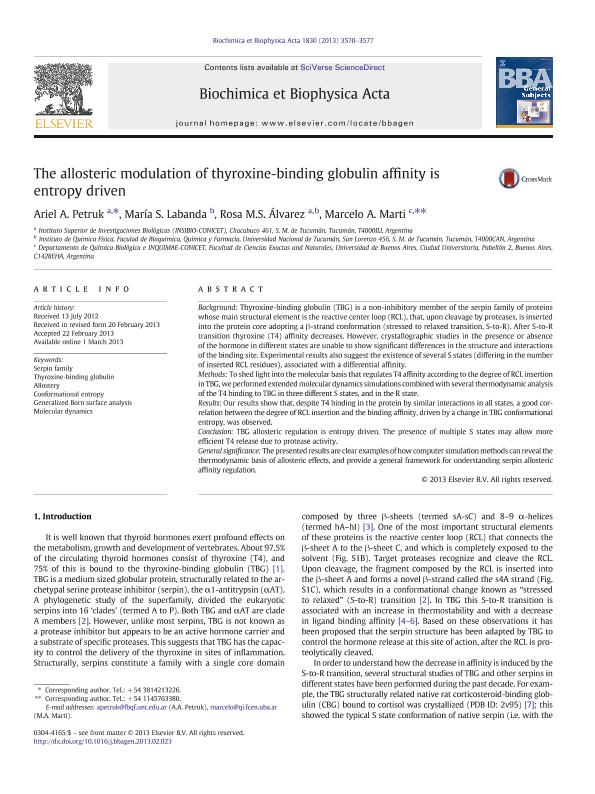Mostrar el registro sencillo del ítem
dc.contributor.author
Petruk, Ariel Alcides

dc.contributor.author
Labanda, María Soledad

dc.contributor.author
Alvarez, Rosa Maria Susana

dc.contributor.author
Marti, Marcelo Adrian

dc.date.available
2017-08-08T15:15:26Z
dc.date.issued
2013-03
dc.identifier.citation
Petruk, Ariel Alcides; Labanda, María Soledad; Alvarez, Rosa Maria Susana; Marti, Marcelo Adrian; The allosteric modulation of thyroxine-binding globulin affinity is entropy driven; Elsevier Science; Biochimica Et Biophysica Acta- General Subjects; 1830; 6; 3-2013; 3570-3577
dc.identifier.issn
0304-4165
dc.identifier.uri
http://hdl.handle.net/11336/22014
dc.description.abstract
Background: Thyroxine-binding globulin (TBG) is a non-inhibitory member of the serpin family of proteins whose main structural element is the reactive center loop (RCL), that, upon cleavage by proteases, is inserted into the protein core adopting a β-strand conformation (stressed to relaxed transition, S-to-R). After S-to-R transition thyroxine (T4) affinity decreases. However, crystallographic studies in the presence or absence of the hormone in different states are unable to show significant differences in the structure and interactions of the binding site. Experimental results also suggest the existence of several S states (differing in the number of inserted RCL residues), associated with a differential affinity. Methods: To shed light into the molecular basis that regulates T4 affinity according to the degree of RCL insertion in TBG, we performed extended molecular dynamics simulations combined with several thermodynamic analysis of the T4 binding to TBG in three different S states, and in the R state. Results: Our results show that, despite T4 binding in the protein by similar interactions in all states, a good correlation between the degree of RCL insertion and the binding affinity, driven by a change in TBG conformational entropy, was observed. Conclusion: TBG allosteric regulation is entropy driven. The presence of multiple S states may allow more efficient T4 release due to protease activity. General significance: The presented results are clear examples of how computer simulation methods can reveal the thermodynamic basis of allosteric effects, and provide a general framework for understanding serpin allosteric affinity regulation.
dc.format
application/pdf
dc.language.iso
eng
dc.publisher
Elsevier Science

dc.rights
info:eu-repo/semantics/openAccess
dc.rights.uri
https://creativecommons.org/licenses/by-nc-nd/2.5/ar/
dc.subject
Thyroxine-Binding Globulin
dc.subject
Serpin Family
dc.subject
Conformational Entropy
dc.subject
Molecular Dynamics
dc.subject.classification
Físico-Química, Ciencia de los Polímeros, Electroquímica

dc.subject.classification
Ciencias Químicas

dc.subject.classification
CIENCIAS NATURALES Y EXACTAS

dc.subject.classification
Biofísica

dc.subject.classification
Ciencias Biológicas

dc.subject.classification
CIENCIAS NATURALES Y EXACTAS

dc.title
The allosteric modulation of thyroxine-binding globulin affinity is entropy driven
dc.type
info:eu-repo/semantics/article
dc.type
info:ar-repo/semantics/artículo
dc.type
info:eu-repo/semantics/publishedVersion
dc.date.updated
2016-07-25T19:30:05Z
dc.journal.volume
1830
dc.journal.number
6
dc.journal.pagination
3570-3577
dc.journal.pais
Países Bajos

dc.journal.ciudad
Amsterdam
dc.description.fil
Fil: Petruk, Ariel Alcides. Consejo Nacional de Investigaciones Científicas y Técnicas. Centro Científico Tecnológico Conicet - Tucuman. Instituto Superior de Investigaciones Biológicas. Universidad Nacional de Tucuman. Instituto Superior de Investigaciones Biologicas; Argentina
dc.description.fil
Fil: Labanda, María Soledad. Universidad Nacional de Tucuman. Facultad de Bioquímica, Química y Farmacia. Instituto de Química Física; Argentina. Consejo Nacional de Investigaciones Científicas y Técnicas; Argentina
dc.description.fil
Fil: Alvarez, Rosa Maria Susana. Consejo Nacional de Investigaciones Científicas y Técnicas. Centro Científico Tecnológico Conicet - Tucuman. Instituto Superior de Investigaciones Biológicas. Universidad Nacional de Tucuman. Instituto Superior de Investigaciones Biologicas; Argentina. Universidad Nacional de Tucuman. Facultad de Bioquímica, Química y Farmacia. Instituto de Química Física; Argentina
dc.description.fil
Fil: Marti, Marcelo Adrian. Consejo Nacional de Investigaciones Científicas y Técnicas. Oficina de Coordinación Administrativa Ciudad Universitaria. Instituto de Química, Física de los Materiales, Medioambiente y Energía. Universidad de Buenos Aires. Facultad de Ciencias Exactas y Naturales. Instituto de Química, Física de los Materiales, Medioambiente y Energía; Argentina
dc.journal.title
Biochimica Et Biophysica Acta- General Subjects

dc.relation.alternativeid
info:eu-repo/semantics/altIdentifier/doi/http://dx.doi.org/10.1016/j.bbagen.2013.02.023
dc.relation.alternativeid
info:eu-repo/semantics/altIdentifier/url/http://www.sciencedirect.com/science/article/pii/S0304416513000743
Archivos asociados
